16. Air Units and Command Structure
Focus: This chapter covers the building blocks to the air war in WiTE2.
Key Points:
- How the air command structure works
- The difference between Air Commands and Air Operational Groups
- How individual planes are allocated to Air Groups
- How the concept of air profiles limits both the upgrade options for air units and the AOGs they can be assigned to
- How to upgrade your air force as new types of planes become available
- The role of air bases
- How individual pilots are tracked and allocated to air groups
- The types and role of anti-aircraft units
16.1 Outline of the Basic Concepts
The air war in WiTE2 tracks individual planes and pilots and allows the player (if they wish) to manage the modernisation of their air forces, their allocation to combat missions and the load-out used by the planes. However, much of the air war is handled automatically by the computer in the Air Execution Phase (5.3.2).
16.1.1 Automation
The player can choose to partly automate the air war. If the ‘AI assist’ option is selected the AI will generate Air Directives (17.4) and allocate air groups to Air Operational Groups according to set priorities. In addition it will rebase planes as the linked HQ is moved on the map.
However, the player will need to make some decisions such as which ground HQ (Axis Army or Army Group, Soviet Front or Military District) an Air Command is assigned to follow and the relative priority (for air group assignment) between the AOGs. This process is summarised in the relevant one page guide (4.6.1).
There are two variants to using the AI-assist. If it is selected as part of setting up a game then the orders will be executed twice each turn when the F12 key is pressed. If this approach is used then in a multi-player game the players will need to decide whether to automate the air war at the start of the game and this decision cannot be changed.
The alternative allows the player to access the AI-assist at any point in a turn. It also allows the player to over-ride those decisions (as long as they do not then press the AI- assist option again).
Practically the two methods yield the same options (and require the same inputs) but they work in different ways allowing a different level of direct player intervention.
If you want to focus on the ground war then it is suggested to use the set-up option and ensure that the required actions are taken each time you press F12.
16.1.2 Pilots, Planes, and Other Air Group Units
While the game engine tracks individual pilots and planes, the lowest command unit available to the player is the Air Group Unit (16.4). This includes a variable number of planes and pilots and can be assigned to a variety of missions depending on the type of planes it is equipped with.
16.1.3 Command Structure
Air Operational Groups (a collection of air group units) report to air commands (for the Germans these are the Luftflotte and Fleigerkorps, other Axis nationalities use their own command structure and the Soviets use Air Armies and some Air Corps). For the Germans, the air commands in turn report to the OKL.
16.1.4 Air Directives
Most actual air missions take place in the Air Execution phase following pre-created Air Directives. This can be set by the computer (17.1) or manually by the player (17.4).
Most bombing and all reconnaissance missions take place this way. Ground Support bombing missions (18.1.3) are created using an air directive but executed during the Ground Execution Phase. The transfer of air units (17.2.5 and 17.3.5) between airbases can be done in either the air planning or ground phase. Air transport (of freight or units) (22.5) and paratroop drops (22.5.3) happen in the ground phase.
Each Air Command can have up to 32 Air Directives at any one time.
16.2 Air Command Structure
The air command structure is different to that used for Ground HQs and primarily exists to enable the allocation of leaders and to provide a means to link air units to ground operations.
16.2.1 Air Headquarters
The actual structure of the air commands varies between the different nationalities.
The Germans use Luftflotte and Fliegerkorps and these in turn report to the OKL.
Axis allies have a mixture of a national Air Command and sometimes a separate formation (such as the Rumanian Combat Air Command) that controlled those air assets committed to the invasion of the Soviet Union in June 1941). These start the game assigned to a German Luftflotte as opposed to their national air commands.
The Soviets mostly use Army Air Formations (air commands and air armies) and these report to Soviet Fronts or Military Districts. In addition at the start the Soviets have the elements of their long range bomber fleet and the various PVO Corps (that are assigned to one of the Army Air Formations).
As the war progresses, AOGs, Air Corps and Air Army commands are added or removed as a result of scripted transfers and reinforcements.
The Air Headquarters are used to assign leaders, and set the relative asset and supply priority.
Note that in addition to their own command hierarchy, Air Commands can be linked to a particular Axis Army or Army Group or Soviet Front or Military District. If the AI assistance is used, this will influence how the planes are based as those ground HQs move on the map.
16.2.2 Air Operational Group Units and Air Commands
Air Operational Groups control the individual air groups and are assigned to a given Air Command. Supply priority can only be set at the Air command/air army level. If wanted, asset priority, and the HQ being followed can be set at corps AOG level (if so ensure that the air command is set first as otherwise that will override any allocations at the AOG level).
Each AOG can command from one to five air groups.
16.2.3 Air Bases and Air Commands
A given air base can have planes from more than one air command.
16.2.4 Theatre Boxes
Each Theatre Box (with the exception of the National Reserve) has a required air garrison strength. Air losses in a Theatre Box will be set by varying the air combat intensity (13.3.1) to reflect shifting events in the wider war.
There are a number of scripted transfers of air units between the Theatre Boxes and the Map and between Theatre Boxes.
Freshly raised air units are placed in the appropriate National Reserve and can be deployed to an airbase on the map when the player is ready. Equally air units can be removed from the map and placed in the National Reserve for training or to refit.
16.3 Air Operational Groups
Air Operational Groups report to one of the levels of the Air Command system and directly control the air groups.
They can be used to automate the control of the air war if you wish to do this (17.1).
If you intend to manually control your air operations then you will still need to allocate air groups to AOGs. In turn the AOGs will be displayed on the map (the label will be roughly central to the locations of the individual air units) and you will need to use these when you wish to move your air groups.
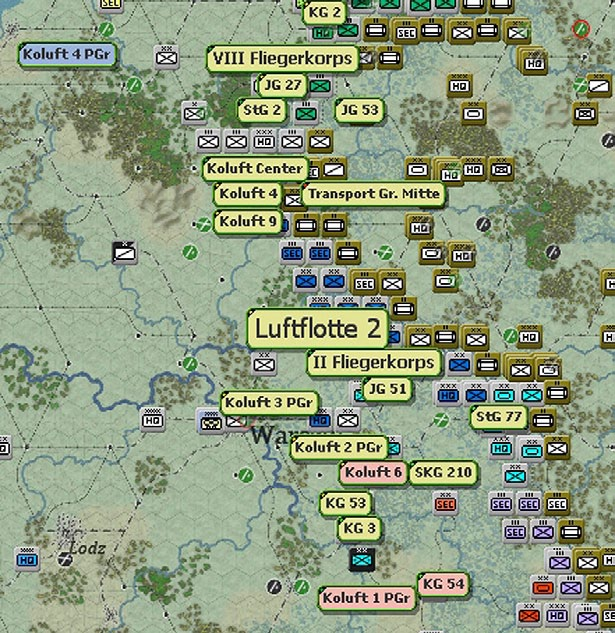
16.3.1 Manual and Automatic (AI Assist) Control of AOGs
The detailed rules for allocation air groups to AOGs, creating Air Directives and moving Air Groups are in sections 17.1, 17.3 and 17.4 respectively.
16.3.2 Air Operational Groups and Air Unit Types
Certain plane types can only be assigned to particular types of Air Operational Groups. Both sides can only assign transport and reconnaissance air units to the appropriate AOGs. These constraints effectively follow the air profiles (16.4.6) that are also used to limit the conversion of planes as new models become available.
For the Germans, the following restrictions apply:
- JG – fighters
- KG(J) – German single-engined fighters
- StG and SG – ground attack aircraft (FB and tactical bombers)
- KG – level bombers
- NAGr/ FAGr/Koluft – recon
- NJG – German multi-engined and single-engined fighters
- NSGr – night bombers, German light bombers, multi- engined fighters and bi-plane bombers
- TG – German transport air groups For the Soviets, the following restrictions apply:
- IAD – fighters and fighter bombers only
- BAD – level bombers
- DBAD – heavy bombers only
- NBAD – night bombers only
- ShAD – tactical bombers
- SAD – Fighters and bombers
Soviet naval only air groups can only be assigned to an AOG with a fleet suffix (16.4.9) such as –CHF.
The air profile (16.4.6) of the types of planes eligible to be assigned to an AOG is shown on the bottom left of the AOG detail screen (if there are any restrictions).

16.3.3 Disbanding and Converting AOGs
Over the game a number of AOGs will arrive as reinforcements, be disbanded (or withdrawn) of convert to a different type. If they arrive as a reinforcement they can be called to the map using the procedures in section 17.3.
In particular a number of Soviet SAD AOGs will (ahistorically) be retained in early 1942 and will be renamed in early Summer 1942. In addition, five of the SAD commands will be retained and will convert to ShAD AOGs in early Summer 1942.
Both these changes are needed or the Soviet player will not have enough AOGs to manage the air force, in particular the SADs are needed to enable usage of the Il-2 formations.
16.3.4 Soviet Guards AOGs and Air Groups
A number of Soviet AOGs will convert to Guards status on their historical dates. This has no direct impact on their performance but will also lead to the upgrade of air groups to Guards status.
For every Guards AOG, usually 3 Air Groups of the appropriate type (16.4.6) will be automatically converted to Guards status (16.4.8). Usually these will be groups directly assigned to the relevant AOG but if that AOG is not currently in use (or lacks sufficient air groups), then groups in the reserve will be converted instead. If there are not enough of these, then air groups in other AOGs will be converted.
Guards air groups gain +5 on their national morale which will raise the average quality of their pilots (16.7).
16.3.5 Axis Allied AOGs
These have some limits as to the nationality of their higher command. They can all be set to report to a German HQ or AOG. However, Rumanian and Slovakian AOGs cannot report to a Hungarian command and Rumanian AOGs cannot report to a Hungarian or Slovakian HQ.
16.4 Air Group Units
Air group units are the basic tactical unit that contain aircraft. Each air group unit is designated by group type, which determines the maximum number of aircraft in the unit, and functional type, which determines the kinds of air missions the unit can undertake. The name of the air group unit usually indicates its function as well. Air group units consist of a number of the same type and model of aircraft that are categorized as ready, damaged or reserve.
Aircraft are characterized by a number of attributes, to include speed, climb rate, maximum altitude, radius in miles, number of engines, armour rating, durability, manoeuvrability, and reliability (37.16.1).
Aircraft carry devices such as machine guns, cannons, rockets, bombs, drop tanks and electronic warfare systems such as radar. Aircraft may have several different load outs of devices that can be selected through the Air Group Unit detail window (37.16.3). Pilots and air crews are assigned to air group units and their aircraft from the manpower pool, with pilots also being tracked individually as they gain experience.
Air Groups that appear as reinforcements will initially be placed in their National Air Reserve (13.2.2). Reinforcement Air Groups do not use pilots already in the pool, but create them when they are placed in the national reserve. The pilots in reinforcement Air Groups will have experience levels that are an average value equal to the Air Group’s experience.
16.4.1 Air Group Unit Status
The Air Unit can be set to one of two main basic statuses. A unit in rest will not be used in the current turn but will regain lost morale and reduce fatigue.
All other Air Units are deemed to be active and will take part in air operations according to the type of plane and Air Directive selected. This includes being set to fly missions only during the day (DO), only at night (NO) or both (DN).
In addition, the method by which the Air Group will change planes to deal either with shortages or when more modern planes become available can be set. The options are M» (this will be done manually by the player) or A (this will be done automatically in the logistics phase using the routines set out in section 16.5).
16.4.2 Fighter Bombers
Fighter Bombers (FB) can be assigned to fly either Fighter Missions or Bomber Missions in the air group unit detail window by selecting the Mission text. The setting determines whether they are available for escort duty or to bomb targets.
The air group unit detail window lists whether the unit is trained as a Fighter or Bomber unit. Fighter bomber air groups trained as fighters will bomb at 80% net effectiveness. Fighter bomber air groups trained as bombers will dogfight with opposing fighters (and fighter-bombers without bombs) as if they had only 80% of their normal experience.
In the Commander’s Report (35.4.1), FB are shown as either Ftr or Bmr according to their current role. If they are ordered to act in a role they are not trained for, this will be shown as Bmr* or Ftr* as in the example below:
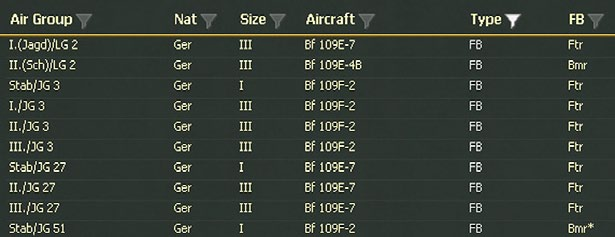
The same designation of a mismatch between current role and training can be found on the unit tab (37.16.3).
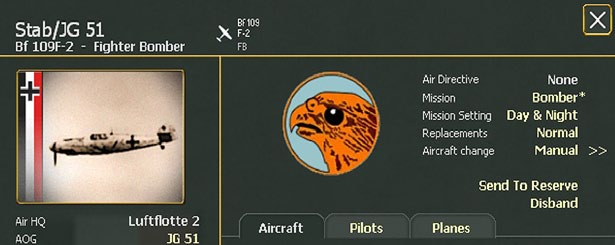
A player can retrain an air group unit by selecting the air group detail screen training type. This will take the unit off the map for 8 turns and when it returns, it will be switched from fighter to bomber or vice versa. For example, a FB air group unit trained as a fighter will bomb at 80 percent effectiveness and dogfight at full experience level. If that air group unit was retrained as a bomber, when it returned it would bomb at full effectiveness and dogfight at 80 percent experience level.
Fighter bombers will dive down to conduct attacks at 1,000 feet altitude if their mission altitude is set at 5,000 and above.
Fighter bombers can only participate in strategic bombing missions as escorts.
Fighter aircraft carrying drop tanks will automatically drop them once they have been used up during the mission. Bomb carrying aircraft will drop their drop tanks at the same time they drop their bombs. Fighters and Fighter Bombers carrying drop tanks and/or bombs will fight less effectively if engaged in air to air combat by enemy interceptors. In such a situation, there is a chance that some of the aircraft will prematurely drop bombs and/or drop tanks to more effectively engage the enemy interceptors.
16.4.3 Aircraft Status
Individual aircraft will be ready (i.e. can fly if assigned), damaged (and need to repaired) or in reserve (due to a lack of aviation support at the airbase and unavailable for air missions).
The number of ready planes is shown on the air command tab (in the example below the AOG has 41 ready and 10 damaged or in reserve:
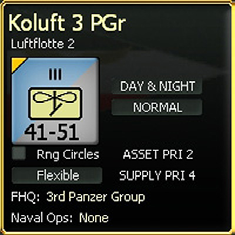
This can also be seen indirectly on the AOG label which shows that 41 planes are available and these constitute 68% of the total aircraft.

Ready aircraft are available to fly in air missions that the air group unit is selected to conduct.
Damaged aircraft require repair and are unavailable to fly, but do count against the maximum number of aircraft allowed by the group type. Damaged aircraft that were not repaired during the maintenance segments of the air execution phase may be destroyed (written off) during the logistics phase. Older aircraft with low durability and low reliability have a greater chance of being written off.
Aircraft are usually placed in reserve status due to a lack of aviation support at their assigned air base unit or a shortage of pilots in the air group unit. Reserve aircraft are categorized as unready and do not fly in air missions, but are considered flyable if the air base unit their air group unit is attached to is captured (16.6.8).
Reserve aircraft are not counted against the maximum number of aircraft in the unit, but may be re-designated as ready aircraft during the logistics phase if the number of ready and damaged aircraft is below the maximum number of aircraft allowed in the unit. If the number of ready aircraft in an air group unit exceeds the maximum number allowed, aircraft designated as reserve in the air group detail window will automatically be sent back to the applicable production pool over a number of logistics phases, while the excess ready aircraft will be moved to the reserve designation over a number of logistics phases.
Note that if the ‘percentage to fly’ has been set (17.4.3) in the air doctrine window then neither damaged or reserve planes count as ready. This may lead to the entire air unit being grounded due to a lack of ready planes.
16.4.4 Air Group Unit Mission Settings
Air group units can be set to operate during day only, night only, or day and night. Alternatively, air group units can be set for rest. Rest means the unit does not fly at all. Air groups in TBs ignore mission settings. Air units in the Reserve TB are available for training missions if they have low experience and are not set to rest.

The mission setting may be changed on the CR screen (individually or in bulk using the mission setting function) or on the unit detail screen for the group (37.16.3).
16.4.5 Air Group Unit Weapon and Fuel Loadouts
Air Group Units have a default loadout determined by the type of aircraft and the assigned mission. The player has the option to change the loadout through the air group unit detail window, which also can be accessed through the Commander’s Report air group unit tab, either individually or for multiple air group units with the same aircraft model.
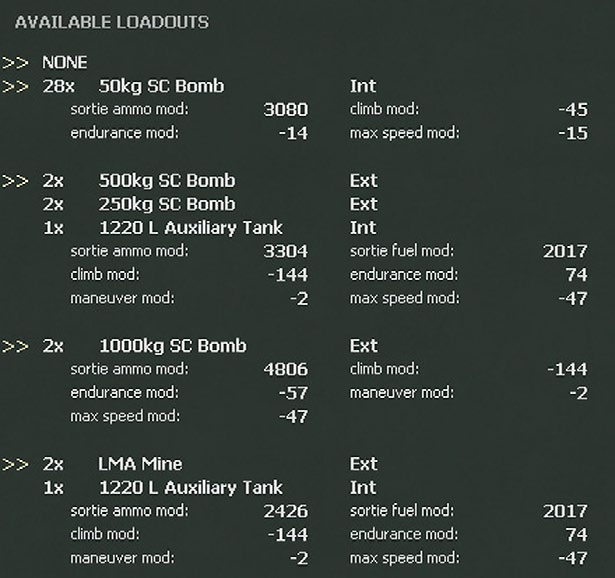
The image above shows some of the loadouts available to the German Ju-88 in June 1941.
Use of manual air group selection allows multiple air group units of the same model assigned to the same type of air directive to change load outs as well (18.2). The type of loadout can impact aircraft effectiveness by decreasing various attributes such as climb rate, speed, and manoeuvrability, though fighters and fighter bombers may drop bombs and/or fuel drop tanks when engaging in air to air combat (19.2).
Note that if planes are at an airbase with low levels of fuel by default a load out with no additional fuel tanks will be selected. If this is done manually, you may find that the available fuel is used up quickly resulting in planes not being available for missions.
If you change the loadout then the performance data for the aircraft may vary and these changes are shown as:
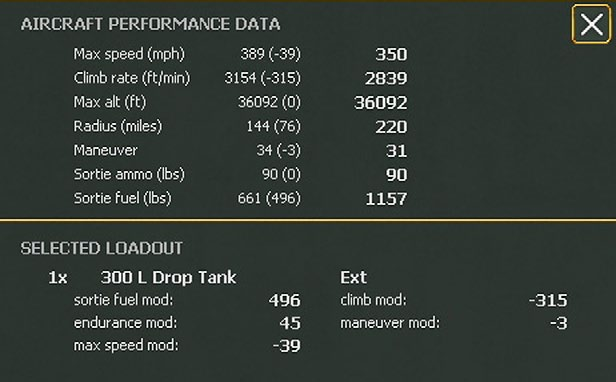
In this case, adding the fuel tanks lower the maximum speed and climb rate and manoeuvre values. In turn the fuel required for the mission is increased and the range extended.
16.4.6 Air Profile and Air Group Unit Types
Air group unit type designations are based on the maximum number of aircraft allowed in the unit, the type of aircraft, and the unit’s nationality. The exact numbers vary by type of group and date and are determined by the current Aircraft Profile for each group, which lists the maximum size for each of three group sizes, corresponding to small, medium and large size groups.
The Air Profile is also used when assigning air units to AOGs (16.3.2) and swapping planes (16.5.1).
Players desiring to know the full list of air plane types and profiles should go to the game editor aircraft tab, select ‘EDIT AIR PROFILES’ and click on the Profile for that type of aircraft. A list of the plane models that fit that profile will then be displayed. An indicative list is in 16.5.1 of this manual.
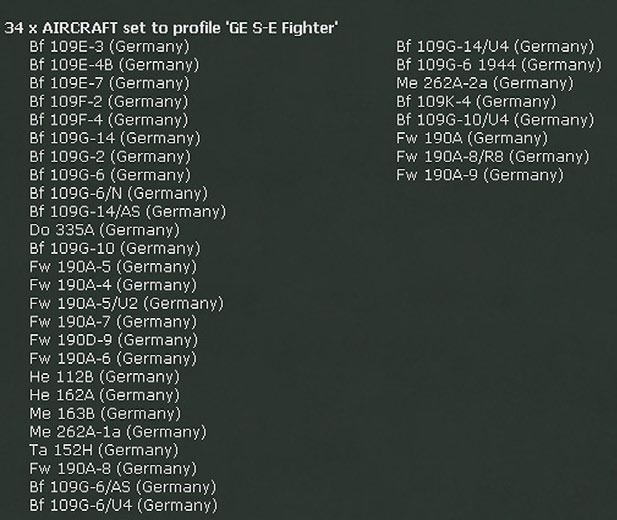
For each individual air group the profile is shown on the unit tab.

In addition each AOG detail screen will show the types of planes it can control (if there are any restrictions).

Note that especially for the Soviets a number of AOGs will change their designation over the game. It is possible this will leave air groups in the AOG that could not be assigned but they can remain in that command with no ill effects.
16.4.7 Axis Air Group Unit Types
The list below shows the maximum number for each air group formation. However, these vary across the game and a German medium bomber group unit would have a maximum size of 3 for a Schwarm, 9 for a Staffel, and 30 for a Gruppe while a German fighter group in July 1944 would have a maximum size of 4 for a Schwarm, 16 for a Staffel, and 68 for a Gruppe.
- Schwarm = 4 aircraft (Germany)
- Staffel = 12 aircraft (Germany)
- Gruppe = 40 aircraft (Germany)
- Escad = 10/12 aircraft (Rumania)
- Grup = 36 aircraft (Rumania)
- Lentu = 12 aircraft (Finland)
- Oszta = 18 aircraft (Hungary)
- Szaza = 9 aircraft (Hungary)
- Sezione = 4 aircraft (Italy)
- Squadriglia = 12 aircraft (Italy)
- Gruppo = 36 aircraft (Italy)
16.4.8 Soviet Air Group Unit Types
- Polk = 20-67 planes depending on type and turn
- Eskadriliya = 2-12 planes
Soviet formations also change their maximum size across the game. The table below is not exhaustive but gives some idea of the main changes to the more common Polk air groups.
The headings are covered in more detail in section 16.4.9 and more information can be found in the game’s editor (41).
| DATE | FIGHTER | BOMBER | GROUND ATTACK | LONG RANGE BONBER | RECON |
|---|---|---|---|---|---|
| At Start | 67 | 62 | 62 | 42 | 62 |
| Aug 1941 | 32 | 32 | 33 | 32 | 32 |
| Sep 1941 | 20 | 20 | 20 | 20 | 20 |
| Apr 1943 | 32 | 30 | 32 | 32 | 30 |
| Jun 1943 | 34 | 30 | 32 | 32 | 30 |
| Dec 1943 | 40 | 32 | 40 | 40 | 32 |
16.4.9 Air Group Unit Names
Though some of the air group unit names in the game are self-explanatory, many use terms and abbreviations that may not be familiar. The lists below are not comprehensive, but are provided to assist in recognizing the type of air group unit from the name.
German Air Group Unit Names
- Stab – Command Flight
- JG (Jagdgeschwader) – Fighter Wing
- NJG (Nachtjagdgeschwader) – Night Fighter Wing
- ZG (Zeröstrergeschwader) – Destroyer (Twin Engine Bf110) Wing
- StG (Stukageschwader) – Stuka Wing
- SG (Schlachtgeschwader) – Battle (Fighter Bomber) Wing
- KG (Kampfgeschwader) – Bomber wing
- SKG (Scnellkampfgeschwader) – Fast Bomber Wing
- NAGr (Nahaufklärungsgruppe) – Short Range Reconnaissance Wing
- FAGr (Fernäufklarungsgruppe) – Long Range Reconaissance Wing
- NSGr (Nachtschlachtgruppe) – Night Bomber Wing
- SG (Schlachtgruppe) – Fighter Bomber Wing
- TG (Transportgeschwader) – Transport Wing
- KGrzbV (Kampfgruppe zur besonderen Verwendung) – Battle Group Special Purposes or Operations
- Lehr – School/Training
Axis Allied Air Group Unit Names
- LeLv (Lentolaivue) – Regiment (Finnish)
Soviet Air Group Unit Names
Soviet air group names include both an indication of the formation’s principle purpose, its status and any wider role or attachment.
The addition of ‘G’ before any other initials indicates the air group had been awarded Guards status (Gvardeyskiy). Initials after the title (in the form –KBF) indicate that the formation was notionally part of a different air organisation than the mainstream VVS formations attached to the Red Army.
Examples of this include:
- PVO (Protivovozdushnaya Oborona) – Soviet Air Defence Forces
- SF (Severnyy Flot) – Northern Fleet
- KBF (Krasnoznamyonnyy Baltiyskiy Flot) – Red Banner Fleet
- ChF (Chernomorsky Flot) – Black Sea Fleet
- GVF (Grazdanskovo Vozdushnogo Flota) – Civil Air Fleet
- PF (Tikhookeanskiy Flot) – Pacific Fleet
The rest of the initials give an indication of the primary function of the formation:
- BAP (Bombardirovchnyy Aviatsionnyy Polk) – Bomber Aviation Regiment
- BBAP (Blizhne-bombardirovochnyye Polki) – Short Range Bomber Aviation Regiment
- DBAP (Dahl’nyaya Bombardirovchnyy Aviatsionnyy Polk) – Long Range Bomber Aviation Regiment
- IAP (Istrebitel’nyy Aviatsionnyy Polk) – Fighter Aviation Regiment
- NBAP (Nochnoy bombardirovochnyy aviapolk) – Night Bomber Aviation Regiment
- MTAP (Minno-torpednyy Aviatsionnyy Polk) – Minelaying and Torpedo-Bomber Aviation Regiment
- MRAP (Morskoy Razvedyvatel’nay Aviatsionnyy Polk) – Naval Reconnaissance Aviation Regiment
- OAS (Otdel’nyi Aviatsion’nyi Aviaeskadril’ya) – Independent Aviation Squadron
- ODRAE (Otdel’naya Dahl’nyaya Razvedyvatel’naya Aviaeskadril’ya) – Independent Long-Range Reconnaissance Squadron
- OIAE (Otdel’naya Istrebitel’naya Aviatsionnyy Aviaeskadril’ya) – Independent Fighter Aviation Squadron
- ORAE (Otdel’naya Razvedivatel’naya Aviatsion’naya Eskadrilya) – Independent Reconnaissance Aviation Squadron
- RAP (Razvedyvatel’nay Aviatsionnyy Polk) – Reconnaissance Aviation Regiment
- SBAP (Smeshannaya Bombardirovchnyy Aviatsionnyy Polk) – Composite Bomber Aviation Regiment
- ShAP (Shturmovoy Aviatsionnyy Polk) – Ground attack Air Regiment
- TAP (Transportnaya Aviahtsiya Polk) – Transport Aviation Regiment
- TBAP (Tyazhelobombardirovochnyy Aviapolk) – Heavy Bomber Aviation Regiment
The various parts of the name are combined so for example TAP-GVF represents one of the civil transport squadrons converted to military service during the war. More commonly, GIAP is the designation of a Guards Fighter Regiment.
16.4.10 Disbanding Air Unit Groups
Air Group Units can be disbanded either using the Commanders Report or the unit screen (37.16.3).

If an Air Group Unit is disbanded then any planes will be returned to the relevant pool and the pilots can be reassigned to other air unit groups.
An Air Group Unit on an isolated air base may not disband.
16.4.11 Creation of New Air Unit Groups
The Axis player cannot raise new air unit groups as this is handled by the reinforcement and withdrawal procedures.
New air units are automatically created for the Soviet player and placed in the National Reserve to train. These will initially be equipped with any planes that are available in the pools including those with low production rates.
To avoid having rare or valuable planes allocated to units with low experience, the Soviet player may need to either disband some of these formations or swap them to use an obsolete plane until they have sufficient experience to be deemed combat ready.
16.4.12 Depleted Air Units
This concept is used by the AI-assist when deciding which air groups to send to the reserve (17.1.9) and is also shown in the Commander’s Report. Air groups are treated as depleted for the Axis if they have less than 25% of their total planes and for the Soviets less than 33%.
In addition, air groups are treated as understrength if they have less than 33% of their planes (Axis) or 50% (Soviet).
16.5 Upgrading and Swapping Aircraft
Dependent on the availability of aircraft models in the production pool, air group units may be changed to a different model aircraft manually by the player or automatically during the player’s logistics phase. The default setting for air group unit upgrades is manual.
An aircraft model has to be in production for at least 1 month before it can be used to upgrade an air group unit. However, it may be used to equip newly raised air groups created as part of the Soviet player’s production system.
These can be manually swapped to an older plane type if the player wishes while the air group unit is in the National Reserve.
Players have the option to manually change (swap) the aircraft model through an air group unit’s detail window (37.16.3), with possible aircraft models listed when the “CHANGE” link has been toggled from “Automatic” to “Manual” (default is manual). Changing the aircraft model in an air group unit may result in up to fifty percent of the new aircraft arriving damaged.
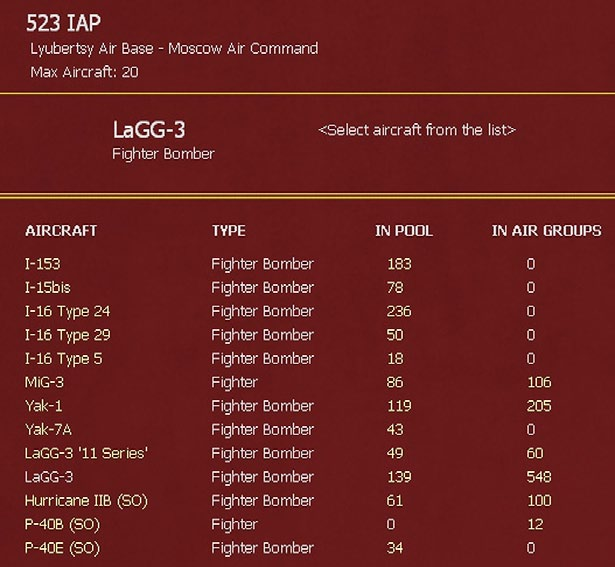
If Manual upgrade is chosen, clicking on upgrade will generate a list of the possible new planes, as seen on the screenshot on the previous page.
The chance of an automatic change increases as a group’s total number of aircraft as a percentage of the maximum number of aircraft in the air group unit decreases. The air group unit cannot have flown any missions yet in the turn and will be unable to fly any missions after the change out.
Some damaged planes may be written off when swapped out.
16.5.1 Air Profiles and Upgrade Restrictions
When upgrading (either manually or using the automatic routines) an air unit can only swap to planes with the same air profile.

The table above lists the main profiles and gives some examples of typical planes in each category.
This information can be found in the editor as indicated above (16.4.6) in the Commander’s Report (35.8.2) and on the air group counter.
Note the plane types in this table are not an exhaustive list but intended to indicate how the air profile works in influencing upgrade options.
16.5.2 Automatic Setting
If the player toggles the “CHANGE” link from “Manual” to “Automatic ,” then in the upgrade sub-segment of the logistics phase, the air group unit may upgrade in accordance with its current aircraft upgrade path as listed in that aircraft model’s city production list window (37.14). It may also downgrade to older aircraft (16.5.4).
In the swap sub-segment, the air group unit may change out the existing aircraft model with an aircraft model of the same functional type, but not necessarily along the upgrade/downgrade path. The computer will only swap out aircraft in air group units that have less than 50 percent of maximum aircraft allowed, with the lower the percentage below 50, the higher the chance for an aircraft swap.
All air units in the non-reserve Theatre Boxes will be set to automatic upgrades.
16.5.3 Manual Setting
An interface window to provide information when upgrading aircraft can be accessed from the air group unit detail window when the group is set for Manual Aircraft Change. Select ‘Manual’.
The window will display the possible aircraft alternatives and for each, the number of aircraft in the pool, the number of aircraft in air group units, and the number of factories. The player can use the selectable links to navigate back and forth between appropriate information windows. Selecting an aircraft model will also allow the player to compare it with the current aircraft model (35.8.4).
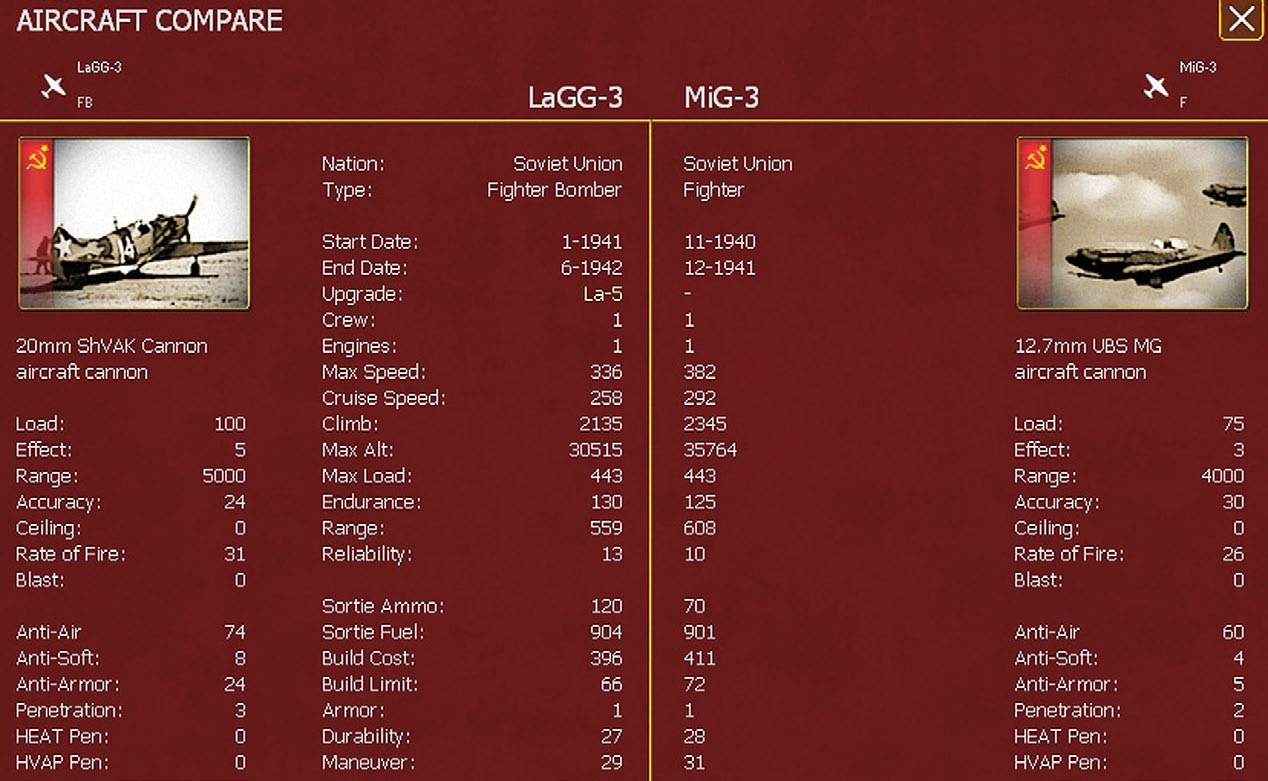
Manual aircraft swaps are not allowed if air base unit to which the air group unit is attached is less than four hexes away from an in supply enemy unit.
16.5.4 Allocation of Older Plane Types
If the air unit was in a Theatre Box (including the reserve) when it changed then the older aircraft are assigned to the transit pool (so it maybe several turns before they can be re-allocated). If the air unit was on the map, then any such planes are moved to the active pool.
16.6 Air Bases
At the start of the game airbases are created on the map as designed for that scenario. As the game progresses the players can create new airbases or to expand the existing ones Each size of airbase can ideally support a certain number of planes (although this can be exceeded) and up to a maximum of 20 air group units (of any size).
The only units that can be attached to air base units are air group units.
Airbases represent the physical and logistical infrastructure required to support air group units, to include airfields, repair facilities and anti-aircraft defenses. Air base units consist of only two types of ground elements, support and air support squad ground elements and anti-aircraft ground elements.
Air base units are fixed facilities displayed on the map area with a symbol denoting their size, which from smallest to largest is 1, 2, or 3 (examples of each type are shown below).
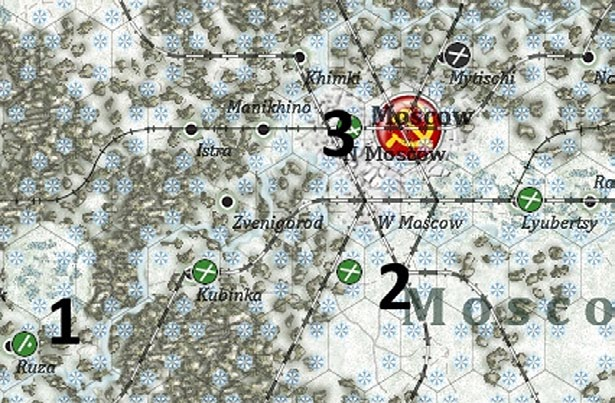
There are multiple ways to access the air base unit detail window (37.16.2).

As set out in section 6.4 one option is to right click on the hex and then select the named airbase. This will create further options to go to the airbase unit detail, to order the expansion of the airbase or to change the supply priority.
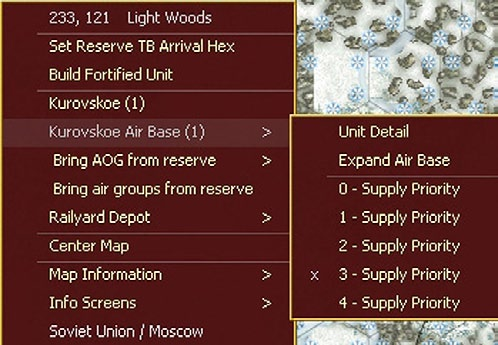
Alternatively, the air base unit detail window can be accessed through the general information and city/airfield box (6.2.2) by either selecting the airfield symbol next to the name of the city or by selecting the city name and then selecting the air base unit name located under the units attached section of the city detail window.

16.6.1 Airbase on Map Display
Air bases on the map are coloured in various ways to indicate their current status and this will vary according to the selection of other display tabs.
Friendly airbases, no logistics tab:
- Red – Airbase has air units, but less than 50% of needed support Green – Has air units
- Yellow – Empty but with air units ordered to transfer there
- Black – Empty airbase
- Orange – Under construction airbase not yet size 1
- If an airbase is overloaded it will be circled in red Enemy airbases, no logistics tab:
- Green – Has air units and has been covered by reconnaissance flights this turn
- Blue – Had air units when last covered by reconnaissance flights but has not been covered by reconnaissance flights this turn
- Black – Empty when last covered by reconnaissance flights
- Yellow – Has never been covered by reconnaissance flights
- Orange – Under construction airbase not yet size 1 Friendly airbases, when logistics tab selected:
- Red – Fuel or ammo <=40% of need
- Orange – Fuel or ammo <= 55% of need but neither <=40
- Yellow – Fuel or ammo <= 70% of need but not neither <=55
- Green – Fuel and ammo >70%
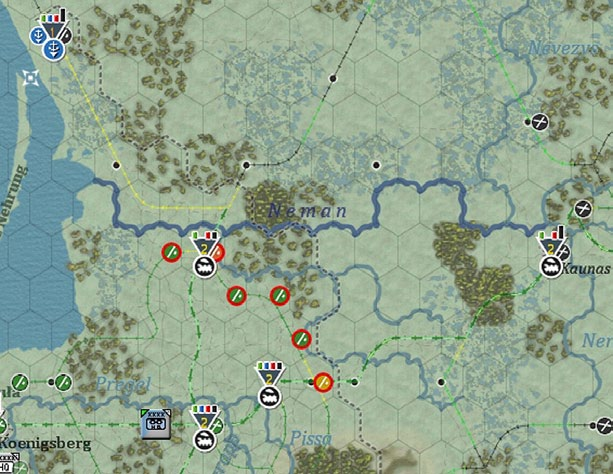
Enemy airbases, logistics tab selected:
- Black – All
16.6.2 Airbose Unit TOE
Airbases at 100% of their TOE will have 250 Air Support elements to service the aircraft (in some scenarios this number may be exceeded at the start of the game).
The TOE for airbases also includes general support squads (21.2.2) and anti-aircraft guns.

Air bases will seek to acquire the elements needed to match their current ToE to the number of planes at the base. This might see air support and other ground elements moved back to the pools if fewer planes are present or moved from the pool if a base now needs more support.
If you use the manual method to move Air Operational Groups then the presence or lack of support assets will determine if the requested move happens automatically or during the logistics phase.
Air base units created along with a temporary port after a successful amphibious invasion automatically try to fill up the air base unit to 100 percent of TOE at the moment it is created. This uses freight that is offloaded at the temporary port from cargo ships attached to the amphibious HQ unit conducting the invasion.
16.6.3 Building and Expanding Airbase Units
The building or expansion of an air base unit can be started by the player in either the air planning or action (move) phase. Players can build new air base units in any non-mountain that was friendly controlled at the start of the turn (7.3.1). This restriction is lifted if the hex already contains a depot or named population centre.
To build or expand an airfield the player can either right click on the map and select the appropriate option, select the air field tab at the top of the screen (6.2.1) or select the city name in the general information and city/airfield box and then selects either ‘BUILD AIR BASE’ or ‘EXPAND AIR BASE’ as applicable in the city detail window (37.13).
The speed of construction is based on the terrain of the hex, supply state and availability of construction and labour support units. The percentage progress of the construction is shown in the city display window.
The number of turns required to build or expand an airbase unit is based on the number of engineers and labour squads in the construction unit assigned to the construction project. This assignment will be done automatically from any HQ that is within range (21.11.4). In addition you can pay Administrative Points and manually assign extra construction Support Units (21.6.2).
Progress will be slower in worse terrain and bad weather. The amount of expansion done in the turn is affected by the ground weather with the construction value: divided by 2 if light mud, by 3 if heavy mud, by 4 if light snow, by 5 if snow, by 6 if heavy snow. The amount is also affected by the terrain in the hex as follows: rough/ woods/urban/2, swamp/heavy woods/heavy urban/tundra/sand /3, mountain /4.
In addition, especially to expand from level 1 to 2 or higher, an airbase will require substantial amounts of supply. If this is not available then progress will be slow.
If an air base unit is bombed while being expanded, all damage must be repaired before expansion work can continue.
As a result of a successful amphibious landing, a size two air base unit with 50 percent damage will be automatically created in the target hex if it is clear terrain.
If an airbase is captured while under construction then any work will stop. The creation of a new airbase can be cancelled at any stage (using either the right click on the map or the display window) until the air base reaches size 1.
While under construction, an airbase is treated as having size 0 and will appear with an orange colour on the map.

16.6.4 AI Assistance and Airbase Creation or Expansion
If you use the AI-Assistance (17.1) to manage the air war, the AI routines will expand existing airbases if it identifies a lack of capacity. However, the player will need to build new level 1 airbases if they feel this is needed.
16.6.5 Airbase Supply Priority
Remember that unlike depots and HQ units, if an airbase is to #0 supply priority it will receive no supply allocation. The supply priority can be changed in the Commanders Report (35.7) or by right clicking on the map hex with the air base or via the general information box (6.2.1).
Airbase supply requirements are set by the number of pilot crews at the airbase not the number of aircraft.
16.6.6 Airbase Capacity
A maximum of 20 air group units can be assigned to an air base unit.
The number of individual aircraft an air base unit can effectively support is dependent on the air base unit size and type of aircraft. Each aircraft, regardless of its state (ready, damaged, reserve) has a support requirement that reflects the number of engines on the aircraft and the air base unit size as follows:
| TYPE | CAPACITY |
|---|---|
| 1 | 100 |
| 2 | 200 |
| 3 | 300 |
Capacity is used up by the number of aircraft*engines, as:
- 1 engine plane = 1 unit of capacity
- 2 engine plane = 2 units of capacity
- 3 engine plane = 2 units of capacity
- 4 engine plane = 3 units of capacity
If the air base unit load percentage exceeds 100 percent, the amount or aviation support available is reduced such that air support will be equal to air support * 100/load percentage. This will slow the rate at which damaged planes are repaired and increase the chance that individual aircraft are treated as being in reserve.
Air base load (capacity) percentage is shown in parentheses on the hex pop-up text for the air base unit after air base unit size. When the air base unit load percentage is over 100, a red ring will be added around the airfield symbol.
If an airbase is overloaded then repair and replacement rates of aircraft will be slowed. In addition, if the airbase is subject to air attack it is more likely that planes will be damaged or destroyed.
16.6.7 Airbase Size and Poor Weather Conditions
Flights flying from size 1 airfields in poor and average road system hexes with light mud and heavy mud may be cancelled.
When planes fly from size 1 bases they have higher chances for operational damage reflecting the poor facilities (usually a bare ground landing strip).
16.6.8 Airbase Capture
Air Base units can be captured and will shift to the phasing player’s control. Note that while air base units cannot be destroyed they may be damaged when they change hands. They will need to repair before they are fully functional.
Note that it can take up to several turns (and at least one complete logistics phase) for the associated manpower and support elements at an airbase to be removed if all the planes are transferred. So if you fear your airbases maybe overrun by the enemy, moving out the planes just before capture will still mean any attached ground and support elements will be lost.
If Air Units are on an airbase that is captured any damaged planes will be destroyed. In addition the Air Unit is given a delay of three turns and then will return in the National Reserve.
16.6.9 Frozen Airbases
Some airbases are frozen at the start of a scenario. The air units cannot be transferred to another base until this restriction is lifted.
16.6.10 Assigning Air Units to Airbases
If you use the AI assist routines, then there is no need to directly assign air units from the national reserve to airbases.
If you wish to handle this manually, then one option is to assign an air unit to an airbase and link it to an existing AOG or to create a new one (17.3.1 and 17.3.2).
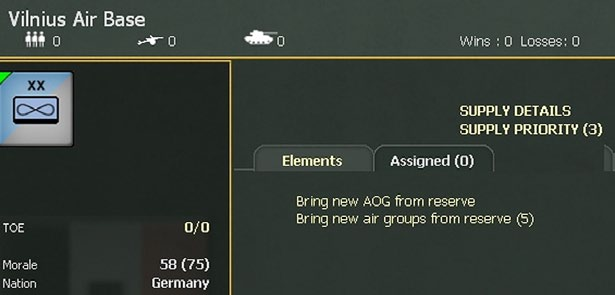
16.7 Pilots
Aircraft in an air group unit must have a pilot and associated crew if required to be in a ready status and fly in an air mission. Pilots and any associated air crew are assigned to air group units up to the maximum size of the type of air group unit.
Pilots will remain assigned to an air group unit unless they are either killed in action, the air group unit is disbanded or the air group is sent to the reserve (16.7.3). Wounded pilots will remain with their assigned air group unit and will eventually be healed and return to flying duties. The air group unit detail window (37.16.13) has a pilot tab for air group units that lists each pilot by pilot number, and shows their experience, fatigue, air kills, missions flown and health status.
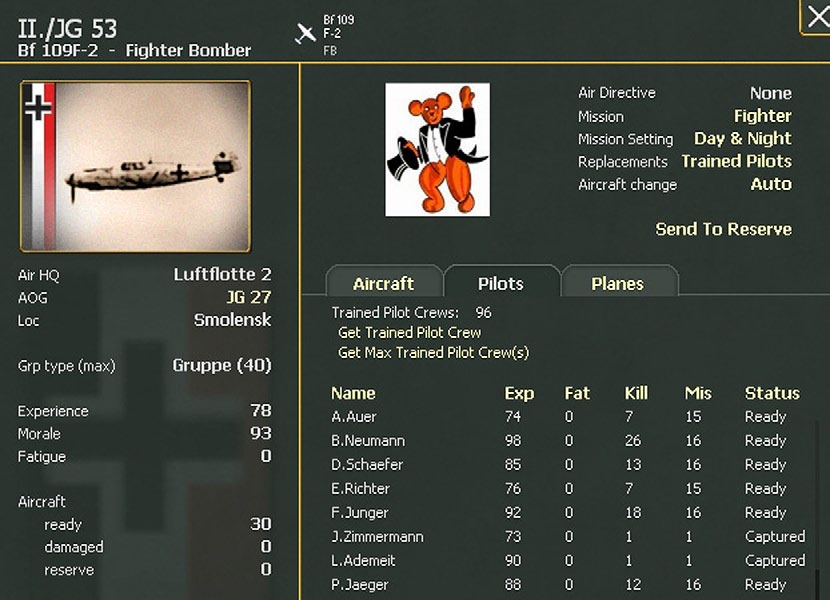
Pilots have both morale and experience (also called skill). Experience is gained in relation to their morale, by winning air combats and (if in the reserve) flying training missions (16.7.4).
Pilots gain and lose fatigue, and experience based on the air missions flown by their aircraft and the experience and fatigue of their assigned air group unit is determined by the average of assigned pilot experience and fatigue. Pilot experience is also tracked by aircraft type at the air HQ unit level where the average experience is displayed in the Air Doctrine Screen pilots tab (37.16.9).
If the air group unit is set to rest, or undertakes no air mission, then all accumulated fatigue will be removed. If the unit has taken part in air missions fatigue will be reset to 25% of the total and this will be carried over into the next turn.
If an air group is sent to the national reserve, its named pilots will be removed (16.7.3).
16.7.1 Assigning Pilots to On-Map Air Group Units
When pilots are initially assigned to an air group unit, they are either trained pilots with experience equal to current air national morale or new pilots with experience equal to only half the current air national morale (12.1 and 38.2). The exception is air group units that arrive as reinforcements in the national reserve, whose pilots will have an experience rating based on the average of the air group units’ set experience rating. Each nation will receive a certain number of replacement trained pilots each turn and any additional pilot vacancies may be filled by new pilots.
The Commander’s Report air tab (35.4.30) has a pilot’s section that displays both the total number of pilots and their status and the pilot pool, which displays the number of available trained pilots. The pilot pool and the manpower pool are separate, but even if trained pilots are listed in the pilot pool, they will not be available unless there is sufficient manpower in the manpower pool for the pilot and any required air crew.
For example, to assign an available trained pilot to a Soviet Pe-8 heavy bomber air group unit, eleven manpower would need to be available for both the pilot and the associated air crew. The options are:
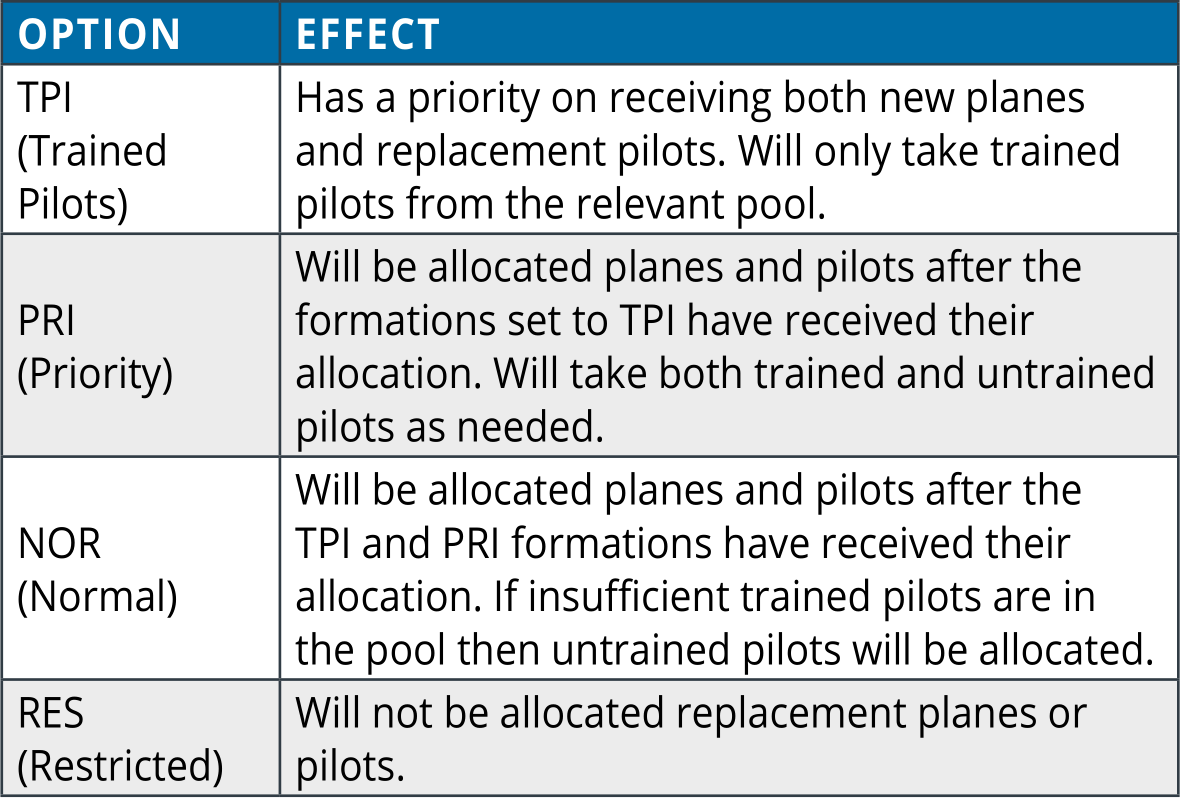
NOR (normal) is the default setting.
Note that units set to TPI will also acquire pilots who were previously assigned to an air group but who are now in the pool. These might have relatively low experience levels compared to that of newly trained pilots (16.7.2) especially if the air group was disbanded relatively soon after being formed. On the other hand, such pilots might have high experience levels due to sustained combat experience.
16.7.2 Experience Levels of New Pilots
The experience of a trained pilot brought into a freshly raised unit is equal to:
(National Morale x 3/4) + (Average Experience of Group Being Joined x 1/4) + rnd(20) - rnd(20)
The experience of an untrained pilot is equal to:
(National Morale x 3/4 x 1/2) + (Average Experience of Group Being Joined x 1/4) + rnd(20) - rnd(20).
16.7.3 Pilots and the National Reserve
When air units are placed in the National Reserve they have no named pilots and instead have an average morale and experience level. This is either determined when the unit is created or reflects their average values before they were transferred.
These values may change over time due to training missions undertaken if the unit has low experience and is not set to rest this turn.
When the unit is returned to the map, a set of named pilots (if enough are available – 16.7.4) are allocated with average morale and experience levels that match the unit value.
16.7.4 Pilot Training
Globally each nation trains a certain number of pilots per turn and these are added to the available pilot pool. These pilots acquire their particular specialism when assigned to an Air Group Unit (16.4).
Air Groups in the National Reserve are considered to undertake training missions. For the Axis, in addition, each turn some units in the Western Europe TB will train.
Training missions can result in an increase in pilot experience and a possible increase in the air group unit morale rating. If pilot experience is higher than that nation’s current air national morale, the chances for experience to increase through training are much lower. In addition, pilots with experience ratings over 50 will have less chance to gain experience through training than pilots with experience less than 50.
16.7.5 Pilot Specialism
When first allocated to an air-group, pilots are then allocated a specialization flag so they can only fly certain types of aircraft.
The types are: Fighter (this includes any Fighter Bombers trained as Fighters), Fighter Bomber, Tactical Bomber, Level Bomber, Recon, Transport and Naval Patrol (Naval Only).
Since trained or untrained replacement pilots are not flagged with a specialization until they are assigned to an air group unit, pilot specialization only matters when an existing air group unit is disbanded and the associated pilots are returned to the pilot pool. At that time, they can only be assigned out to an air group unit that meets their specialization criteria. For example, if the Axis player disbands a number of level bomber air group units, the pilots from those air group units will not be available to fill vacancies in fighter air group units.
16.8 Anti-Aircraft Units
Anti-Aircraft Support Units in WiTE2 have a number of functions and types. Some represent fixed emplacements designed to protect cities from strategic bombing while some others represent the mobile AA formations designed to protect ground units and HQs from tactical air attacks.
AA Units attached to combat units and HQs behave like other Support Units (21.5) when entering ground combat and when being moved between HQs and Units. They affect air missions as set out in sections 19.3.4 and 19.3.5.
AA Units attached to cities only affect air missions and there are special rules for the process and cost of moving them between cities or to attach them to HQs (38.1).
Anti-aircraft support units attached to cities will never have a range penalty for being far from their HQ units (15.5.4) during admin checks for resupply.
16.8.1 German Anti-Aircraft Units
Flak Units include both those that supported mobile operations against the Soviet Union and those that defended the Reich against Allied bombers. Most of the latter will only be found in the various Theatre Boxes or assigned to major cities in the Reich. These Flak Regiments represent the concentrated flak defences organized around defending strategic targets (ports, production centers etc.). These regiments have almost no mobility and were either crewed by the Kriegsmarine or by limited numbers of Luftwaffe personnel. As the war progressed, after 1942, an increasing number of flak units defending the Reich were manned by factory workers, teenagers, local Wehrmacht troops deployed as garrisons, women and even Allied POWs.
The individual flak battalions and companies represent the tactical flak units that were manned by Luftwaffe personnel and either guarded tactical and/or operational objectives or friendly troops from enemy tactical fighters and bombers and could possibly engage in ground combat. These battalions had the best mobility and can be attached directly to combat units.
Over time you will notice a number of these will disband. Historically the Germans re-organised their mobile units by increasing the amount of organic AA in the divisions at the expense of these individual battalions.
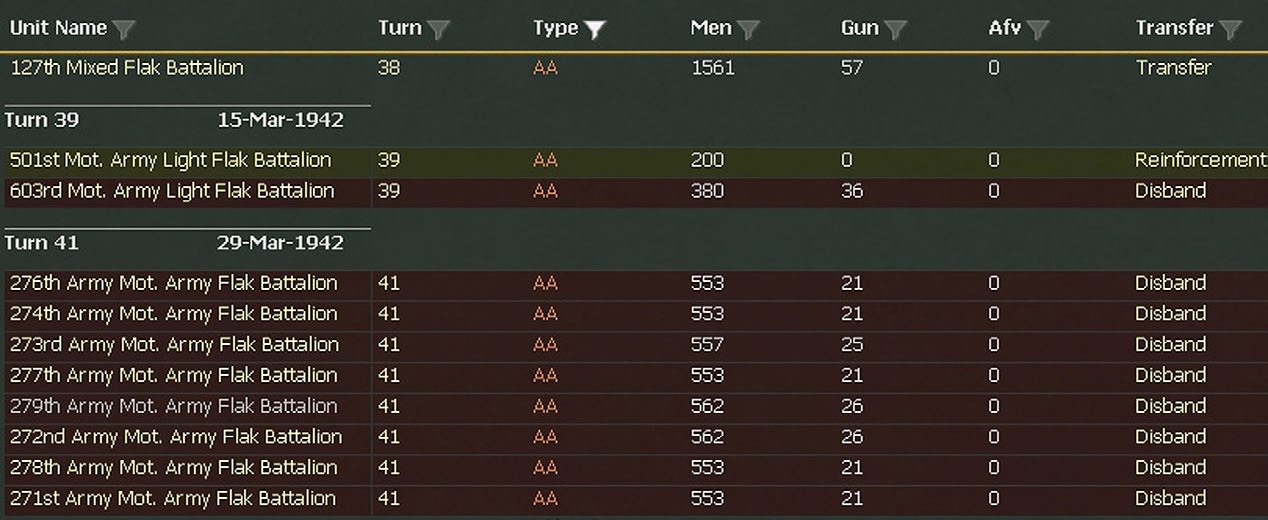
16.8.2 Soviet Anti-Aircraft Units
The main difference between Soviet Anti-Aircraft units is between those designated as PVO and the rest. PVO (Voyska Protivovozdushnoy Oborony) formations were designed purely for the defence of urban areas. In-game, these all start attached to cities and the costs to re-assign them to other roles are set out in section 9.2. In practice, Soviet AA Support Units are treated as either attached to HQs and combat units (21.5.1 and 21.5.2) or to cities (21.5.3) for their employment and the costs of re-assignment.